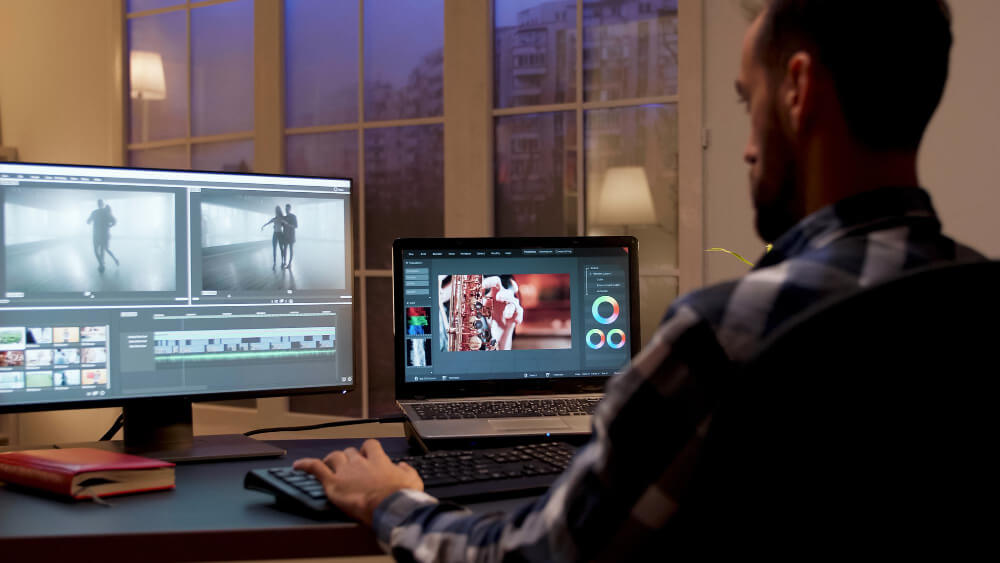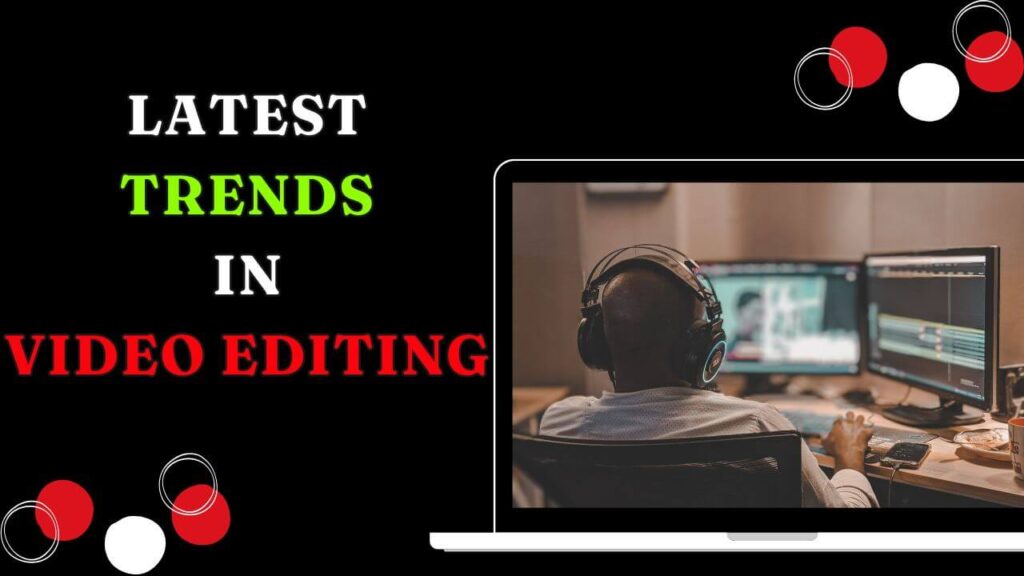Video editing is constantly evolving, driven by new technology and changing viewer preferences. Whether you’re a professional editor, a content creator, or someone interested in making better videos, staying on top of the latest trends is crucial. These trends not only help you keep your content fresh but also ensure it resonates with your audience. In this article, we’ll explore the latest video editing trends you need to know about.
We’ll dive into each trend and explain why it’s important for your videos. We’ll also share practical tips on how to incorporate these trends into your editing process.
1. AI-Powered Video Editing: A Leading Trend

Artificial Intelligence (AI) is no longer a thing of the future—it’s here, and it’s transforming video editing. AI-powered tools can now automate many aspects of editing, saving you time and effort.
How AI is Shaping the Latest Video Editing Trends
For instance, AI can handle tasks ranging from automatically cutting out dead space in your footage to color grading, and even suggesting music that matches the mood of your video. Furthermore, AI-driven features like auto-tagging, facial recognition, as well as voice recognition help streamline the editing process.
Why It Matters
AI tools allow editors to focus more on the creative aspects of editing, rather than getting bogged down in repetitive tasks. This results in faster turnaround times and more polished final products.
How to Use It
Incorporate AI tools like Adobe Sensei or Magisto into your workflow to speed up tasks like scene detection, color correction, and audio enhancement.
2. 360-Degree Video Editing: A Trend On The Rise

As a result of the rise of virtual reality (VR) and augmented reality (AR), 360-degree videos are becoming increasingly popular. In addition, these videos offer an immersive experience that standard videos simply can’t match.
How 360-Degree Videos Fit into the Latest Video Editing Trends
Essentially, these videos capture the entire environment around the camera, allowing viewers to explore different angles by moving their device or using VR headsets. Moreover, editing these videos involves stitching together footage from multiple cameras, adding special effects, and ensuring seamless transitions.
Why It Matters
360-degree videos are particularly popular in industries like real estate, travel, and gaming, where immersive experiences can make a significant impact. As more platforms support 360-degree content, being able to edit these videos can set you apart from the competition.
How to Use It
To start editing 360-degree videos, you’ll need software that supports it, like Adobe Premiere Pro or Final Cut Pro. Practice stitching together multiple shots and experiment with adding interactive elements to enhance the viewer experience.
3. Motion Graphics and Animation: A Creative Trend

Motion graphics and animation are no longer just for cartoons or explainer videos. They’re being used more and more in corporate videos, marketing content, and even social media posts.
What Are Motion Graphics?
Motion graphics involve moving text and visuals to create engaging content. They’re often used to explain complex ideas, highlight key points, or add a creative flair to videos.
Why It Matters
In fact, motion graphics can make your videos more dynamic and engaging. Additionally, they help break up long segments of talking heads, thereby keeping viewers interested. Moreover, they’re highly shareable on social media, which in turn increases your video’s reach.
How to Use It
Start by using templates in tools like After Effects or Motion to create simple animations. As you become more comfortable, try creating custom animations that align with your brand’s style.
4. Vertical Video Editing: A Mobile-Centric Trend

Due to the rise of social media platforms like TikTok, Instagram, and Snapchat, vertical video has quickly become the preferred format for mobile content. Consequently, this trend has significantly shifted how editors approach video creation.
Why Vertical Video is Leading in the Latest Video Editing Trends
Nowadays, more people are consuming content on their phones, so vertical video fits perfectly into a smartphone screen. As a result, this eliminates the need for users to rotate their devices, thereby making it easier and more natural to watch videos.
Why It Matters
Ignoring vertical video means missing out on a huge audience. As more platforms prioritize vertical formats, adapting your editing style to include vertical videos is essential.
How to Use It
When filming, consider the composition with vertical framing in mind. Use editing software like Final Cut Pro or Premiere Pro to crop or resize footage to fit vertical dimensions. Make sure text and key elements are centered to avoid them getting cut off.
5. Color Grading for Mood Setting: A Powerful Trend

Color grading has always been an essential part of video editing, but its role has expanded beyond just correcting color. Now, it’s being used as a powerful tool to set the mood and tone of a video.
How Color Grading Enhances the Latest Video Editing Trends
In essence, color grading involves adjusting the colors in your footage to effectively achieve a certain look or feel. For example, this could mean making a scene warmer to naturally convey comfort, or cooler in order to suggest tension.
Why It Matters
The right color grading can significantly enhance the emotional impact of your video. It helps tell your story in a more visually compelling way, making your content more memorable.
How to Use It
Experiment with different color grading styles in your editing software. Tools like DaVinci Resolve or Premiere Pro offer advanced color grading options. Start by using presets and then adjust the settings to match the mood you want to convey.
6. Minimalist Editing: A Trend Toward Simplicity

In a world filled with information overload, less is more. Minimalist editing focuses on simplicity, using only the essential elements needed to tell your story.
Minimalist Editing as One of the Latest Video Editing Trends
This approach avoids excessive effects, transitions, or graphics. Instead, it emphasizes clean cuts, simple transitions, and straightforward storytelling.
Why It Matters
Minimalist editing helps keep your audience focused on the content rather than being distracted by flashy effects. It’s especially effective in corporate videos, educational content, and interviews where the message is key.
How to Use It
Focus on clear, concise editing that serves the story. Use simple cuts, minimal text, and clean transitions. Let the content speak for itself without unnecessary embellishments.
7. Remote Collaboration in Video Editing

With more teams working remotely, the ability to collaborate on video editing projects from different locations has become crucial.
How Remote Collaboration Works
Cloud-based editing platforms like Frame.io or Adobe’s Team Projects allow multiple editors to work on the same project simultaneously. This makes it easier to share feedback, make revisions, and keep the project moving forward.
Why It Matters
Remote collaboration tools save time and make it easier to involve team members in the editing process, no matter where they are. This is particularly useful for larger projects that require input from multiple stakeholders.
How to Use It
Choose a cloud-based platform that integrates with your existing editing software. Set clear communication guidelines and use tools like version control to keep track of changes.
FAQs about Video Editing Trends
Q: How can I stay updated with the latest video editing trends?
Follow industry blogs, attend webinars, and participate in online forums. Subscribing to newsletters from editing software companies can also keep you informed about new features and tools.
Q: Do I need expensive software to implement these trends?
While professional software offers more advanced features, many trends can be achieved with more affordable or even free tools. For example, DaVinci Resolve offers powerful color grading tools for free.
Q: How do I know which trends are right for my videos?
Consider your audience and the platform where your videos will be published. Trends like vertical video are crucial for social media, while AI tools might be more useful for longer, more complex projects.
Q: Are these trends just fads, or will they stick around?
While some trends may fade, many are rooted in broader technological advancements or shifts in viewer behavior, suggesting they’ll be around for the long haul.
Q: Can I combine multiple trends in one video?
Absolutely. For example, you can use AI tools to automate parts of your editing process while incorporating motion graphics and color grading to enhance the final product.
Conclusion
Video editing is more than just cutting footage—it’s about staying ahead of the curve and incorporating the latest trends to create engaging, professional content. From AI-powered tools to minimalist editing, these trends can help you produce videos that not only look great but also resonate with your audience. By understanding and applying these trends, you can elevate your video editing skills and keep your content fresh and relevant.
By understanding and applying these trends, you can elevate your video editing skills. For beginners, make sure to read our guide on the Top 5 Video Editing Apps and Software for Beginners to find the perfect tools to kickstart your journey.
